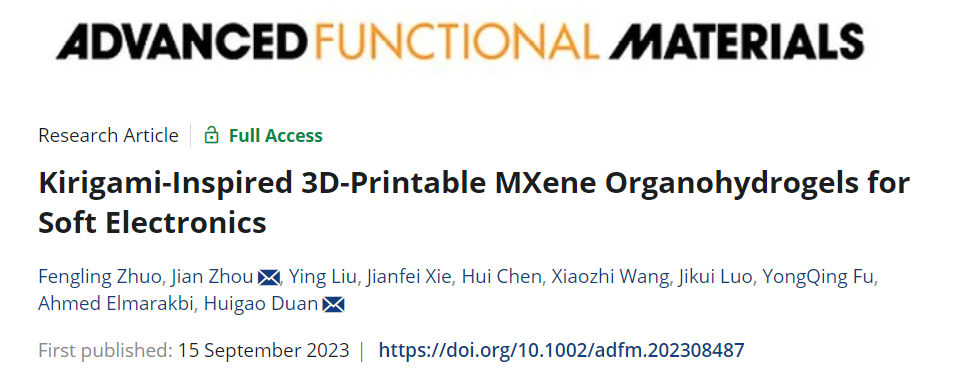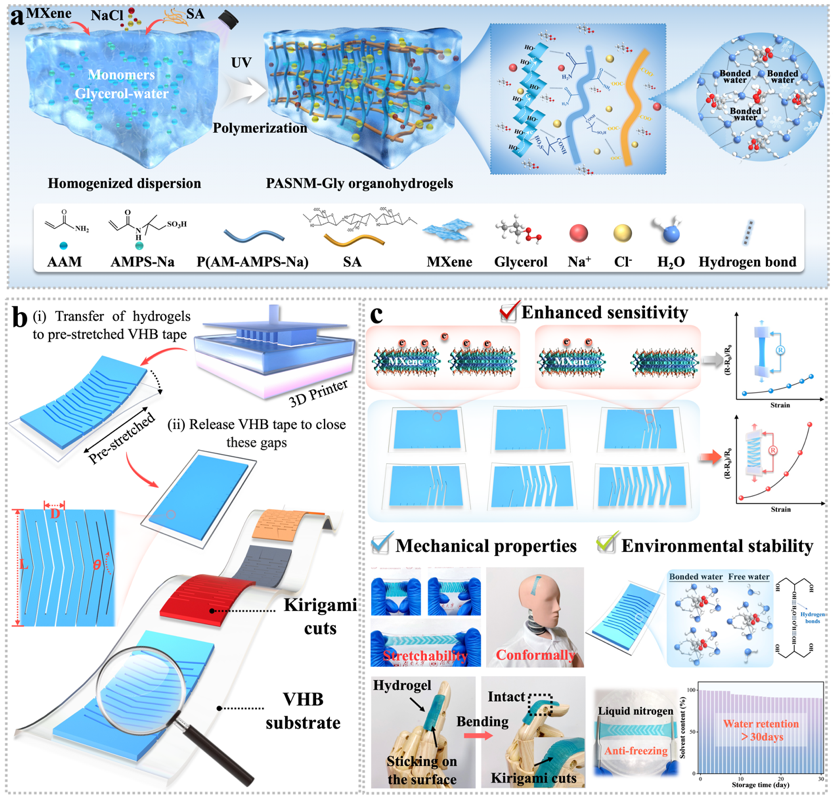Conductive hydrogels are ideal materials for developing flexible and stretchable sensor devices. However, achieving key characteristics such as high sensitivity, excellent stretchability, and environmental stability simultaneously has been challenging, limiting their widespread application. Recently, Professor Duan Huigao’s team from Hunan University proposed an engineering strategy inspired by Kirigami paper-cutting structures, significantly enhancing the strain sensitivity of organic hydrogel strain sensors, and enabling underwater human-machine interaction systems and wearable artificial intelligence recognition of Morse code. The results were published in the renowned academic journal in the field of international materials and devices, Advanced Functional Materials (IF 19.0, https://doi.org/10.1002/adfm.202308487), with the first author being Zhuo Fengling from the School of Mechanical and Transportation Engineering at Hunan University, and the corresponding authors being Professor Duan Huigao and Associate Professor Zhou Jian from the same school.
This paper describes the preparation of organic hydrogels with a multi-interpenetrating network structure by introducing sodium alginate nanofibers and conductive MXene nanosheets into a polymer double network permeated with a glycerol-water binary solvent. These hydrogels exhibit excellent stretchability (>5000%), good sensitivity, and moisture retention properties (>30 days). To further enhance the sensing sensitivity, Kirigami paper-cutting structure hydrogels were designed and fabricated using 3D printing technology, and their mechanical behavior and strain sensing mechanism during stretching were systematically studied using finite element analysis. Based on the relative slip effect of MXene nanosheets at the microscopic scale and the macro-scale enhancement strategy of the Kirigami structure, the strain sensitivity of this hydrogel sensor reached 29.1, while also exhibiting rapid response characteristics and good cyclic durability. Based on this sensor, a smart glove was developed, integrated with an industrial robotic arm to grasp underwater objects, demonstrating advanced underwater human-machine interaction capabilities. Additionally, by integrating machine learning algorithms, a wearable Morse code recognition and translation system was developed, achieving high accuracy (>99%) and fast recognition time (~0.17 ms) for Morse code signals of letters, numbers, and sentences. This research provides a new approach for developing organic hydrogel sensors with high sensitivity, stretchability, and environmental stability.
This work was supported by the National Natural Science Foundation (52075162), the Huxiang Youth Talent Program (2023RC3099), and the Hunan Provincial High-tech Industry Innovation Leading Program (2021GK4014); it also received strong support from Professor Fu Yongqing of Northumbria University, Professor Xie Jianfei of Central South University Xiangya Third Hospital, Professor Luo Jikui and Associate Professor Wang Xiaozhi of Zhejiang University.
Figure 1 illustrates the core concept of this research, including the 3D network formation mechanism of organic hydrogels, the engineering strategy of Kirigami paper-cutting structures, and the performance of the fabricated sensor devices.

Figure 1 Schematic diagram of the synthesis of organic hydrogels and the preparation of Kirigami structures, as well as sensor performance.
Figure 2 shows the Kirigami paper-cutting structure design of the hydrogel sensor, including patterns of 8 types of paper-cutting structures and corresponding structural simulations, as well as differences in sensor performance based on different structures. The enhancement mechanism of the paper-cutting structure on the strain sensitivity of the sensor is analyzed and elaborated.

Figure 2 Kirigami paper-cutting structure design of organic hydrogel sensors.
Figure 3 demonstrates the strain sensing performance of the organic hydrogel sensor based on the Kirigami paper-cutting structure, including enhanced strain sensitivity, rapid response time, good dynamic characteristics, and cyclic durability. Compared to hydrogel sensors reported in the literature, the sensors in this study can simultaneously achieve high sensitivity, excellent stretchability, and environmental stability.

Figure 3 Key sensing performance of organic hydrogel sensors based on Kirigami paper-cutting structures.
Figure 4 shows the underwater human-machine interaction system composed of the smart glove based on this hydrogel sensor and an industrial robotic arm. Experimental results indicate that volunteers wearing the smart glove can remotely control the mechanical claw of the industrial robotic arm to grasp underwater objects.

Figure 4 Underwater human-machine interaction application.
Figure 5 presents the wearable Morse code recognition and translation system developed in this study, which has high recognition accuracy and fast recognition time, showing potential applications in assisting individuals with speech disabilities in normal communication.

Figure 5 Wearable Morse code intelligent recognition system.
Source: Polymer Science FrontiersDisclaimer: The views expressed are solely those of the author. The author acknowledges limitations in their expertise; please feel free to provide corrections in the comments below!Recommended ReadingProfessor Chen Xueye’s team from Ludong University Chem. Eng. Sci: Microfluidic Sweat Glucose Monitoring System Based on Copper Oxide Embedded Laser-Induced Graphene15000 Times Stretchable Inorganic Hydrogel: A Flexible Revolution and Sustainable FutureFrom Perception to Cognition: Biomimetic Textile Sensing Systems Unlock New Frontiers in Robotic Texture RecognitionMental Fatigue Monitoring—Transfer Learning Enhanced Multimodal Ultra-thin Epidermal Electronic SystemsBeihang University National New Institute Review in Nano-Micro Letters: MXene-Based Neuromorphic Computing Platform!Hierarchical Porous Aerogel-Hydrogel: Low Voltage Cardiac Pacing and Dynamic Signal MonitoringVideo Channel:#Flexible Electronics Insights
